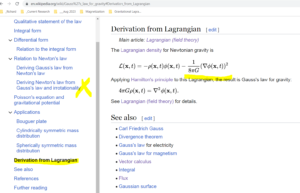Ben about the gravitational potential, gravitational energy density, global collaborations
Subject: Found the derivation of the gravitational energy density in a workable form
Ben,
Most humans live in little bubbles and are only vaguely aware of the whole. So global policies, issues and opportunities are made up by many billions of people acting independently. Or for “smaller” policies, issues and opportunities – millions, hundreds of thousands, tens of thousands, thousands, hundreds. The smaller the group the less likely there is sufficient knowledge. But “all human knowledge” is too much for all humans to use – unless the human species can get help from true AIs.
So I am working now on “true AI” global policies, issues and opportunities.
Oh. I was reading “Gauss’s law for gravity” on Wikipedia and they show “Derivation from Lagrangian” and there is my “gravitational energy density” that I have been using for the last 46 years !!
When I was studying gravity at University of Maryland at College Park, Charles Misner was my academic advisor on paper. But I was working with Steve Klosko at Wolfe Research using satellite orbital data to create a NASA model for the precise gravitational potential field for the earth (a “geopotential”. That was real data, real spacecraft, real measurements, real working models that gave precise results. Then Misner, Thorne and Wheelers group were all blathering endlessly “Einstein this” and “Einstein that” and using this horribly clumsy paper mathematics based on tensors that is always approximate and basically untestable unless you go to measurements. Then I met Joe Weber and he guided me to Robert Forwards work. Both of them were “engineers”, they hated ‘useless theory” but did not have the tools then to do what they wanted to do. But Robert Forward used the gravitational energy density, g^2/(8*pi*G). I literally have spent many tens of thousands of hours checking where that gets measured, how it is calculated, where it converts into other form. But I did not know how it linked back to those theorists who were almost always wrong – because they never measure anything. They never test. Now Robert Forward set up gravitational radiation detectors so new generations can measure, but they face the entrenched old paper mathematics people who control most of the money still.
Humans using paper methods, in places of power, control most of the worlds resources, because there is no way to verify their memories, nor to trace their actions. If AIs can audit recorded knowledge and all interactions of projects and systems are monitored, then there can be some measure of verification. Except humans using paper, control all the systems. I guess “not in my lifetime”
My example of “Use electromagnetic and acoustic fields to lift SpaceX Starship second stage to the height and velocity needed for the missions” requires about 36 GigaWatts for a few minutes. But it saves 130 GW in chemicals by NOT requiring the booster stage at all. You lift and power the second stage when you send it out, and you catch and lower on re-entry. And the energy can be beamed and streamed to the vehicle so it can use that with lower cost propulsion units. “An electric rocket”.
Nothing is really difficult for the people who use supercomputers. And the animation groups GREATLY reduced the cost of getting realistic simulations. And the GPT AI groups greatly reduced the cost of running large global research collaboration – EFFICIENTLY.
I cannot tell you how satisfying it is to finally have the pieces fit together. I will see if I can animate the example of “lift rockets up to height and velocity”. In my mind, from 54 years (I started using the gravitational potential at the CIA for satellite orbit determination when I was an undergraduate) the fields are real, 3D, time dependent AND linked to global networks of all the sensors and groups who work on gravity.
It is the integration of human groups, their models and data that changes the equation for “global policies, issues and opportunities”.
GravitationalLagrangian = Density*GravitationalPotential + GravitationalEnergyDensity
GravitationalLagrangian = Density*Phi_g + g^2/(8*pi*G)
g = – Gradient(Phi_g) is the gravitational acceleration field.
It is the integration of human groups, their models and data that changes the equation for “global policies, issues and opportunities”.
Dad
https://en.wikipedia.org/wiki/Gauss%27s_law_for_gravity#Derivation_from_Lagrangian

https://en.wikipedia.org/wiki/Vector_calculus_identities
A: Magnetic Vector Potential
B: Magnetic Field in Tesla B = Curl(A)
Phi_g: Gravitational Potential field
g: Gravitational Acceleration Field g = Grad(Phi_g)
Density: Mass Density Field defined for every voxel
Curl(Phi_g * A) = Phi_g*Curl(A) + Grad(Phi_g) x A
Curl(Phi_g * A) = Phi_g * B + g x A
The curl of “the product of the gravitational potential times the magnetic vector potential” equals “the gravitational potential times the magnetic field” plus “the gravitational acceleration cross the magnetic vector potential”.
Grad(Density*Phi_g) = Density*Grad(Phi_g) + Phi_g * Grad(Density)
Grad(Density*Phi_g) = Density*g + Phi_g * Grad(Density)
The gradient of “the mass density times the gravitational potential field” is equal to “the mass density times the gravitational acceleration” plus “the gravitational potential times the density gradient field”.